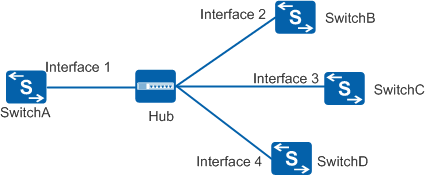Unidirectional Link Detection When Multiple Neighbors Exist
DLDP can be configured for devices connected by hubs to detect unidirectional links. Each interface detects at least one neighbor.
As shown in Figure 1, a hub connects SwitchA to SwitchB, SwitchC, and SwitchD through copper twisted pairs or optical fibers. All switches support DLDP. To detect unidirectional links on this network, enable DLDP on all switch interfaces connected to the hub.
On a network with multiple neighbors, an interface immediately enters the Disable state when receiving Disable packets from a neighbor or detecting that a neighbor is unidirectional. When SwitchA, SwitchB, and SwitchC detect a unidirectional link fault on SwitchD, they transition to the Disable state. This prevents traffic forwarding errors when the topology changes. If the Rx optical fiber between SwitchB and the hub is disconnected when SwitchA is forwarding traffic to SwitchB, SwitchA shuts down its interface connected to the hub and stops sending packets to SwitchB, SwitchC, and SwitchD. If a backup link exists between SwitchA and SwitchB, STP immediately starts the backup link when SwitchA shuts down the interface.
If the switches on the preceding network are connected by a device that has DLDP disabled but supports DLDPDU forwarding, DLDP still detects unidirectional links as if the network has multiple neighbors.
